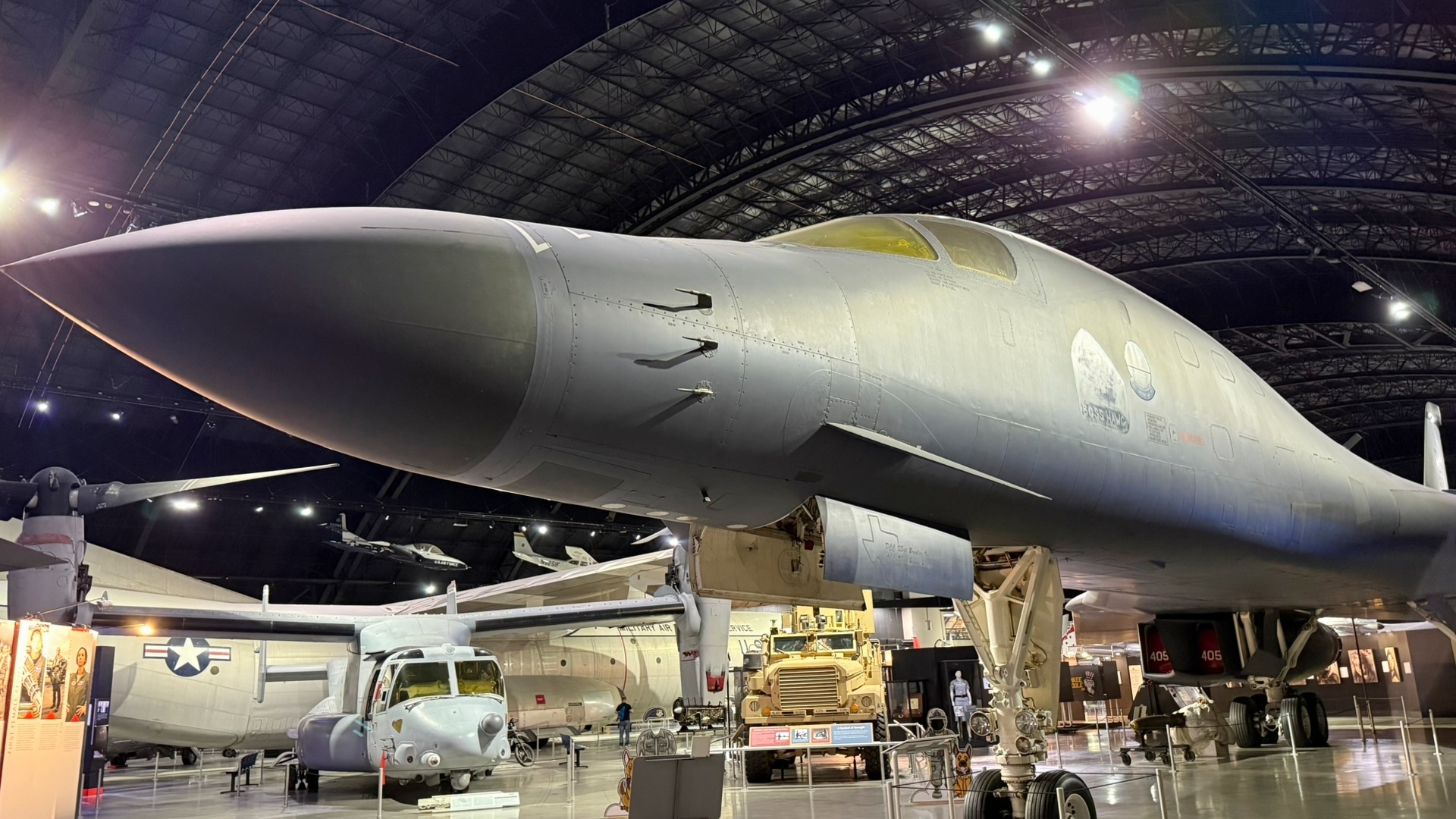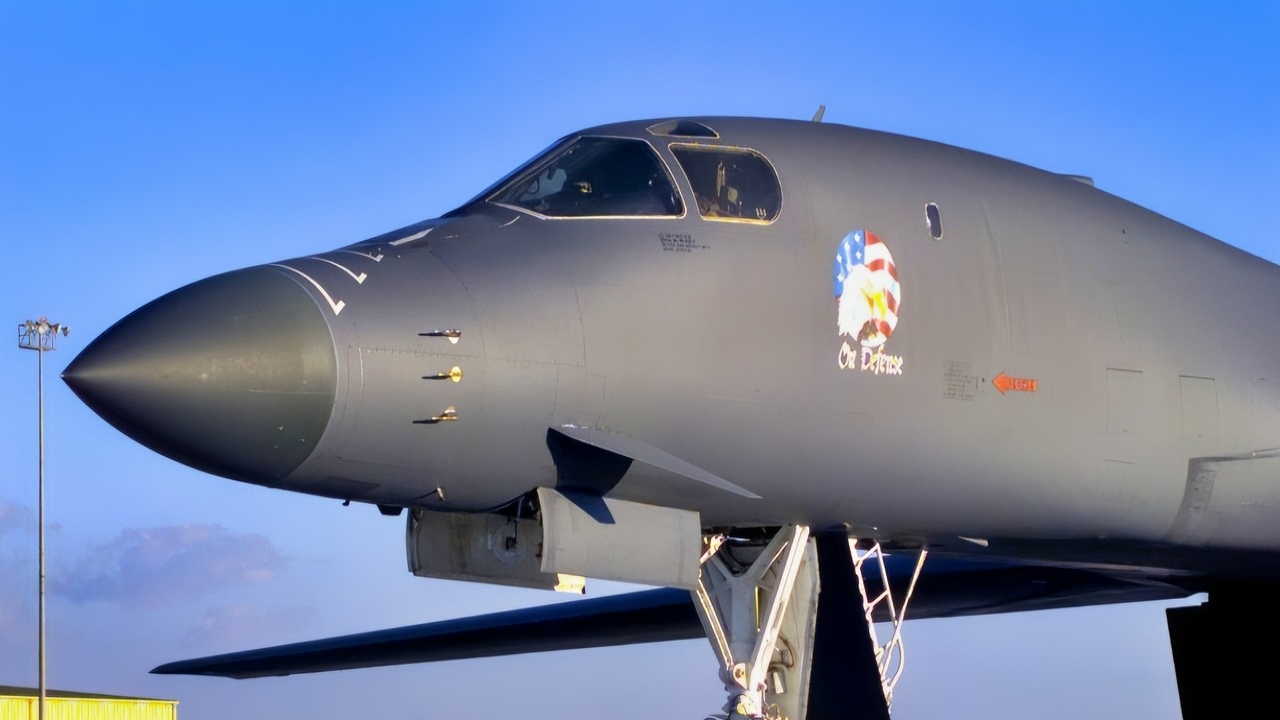Key Points and Summary – The Air Force has twice turned to the Arizona “boneyard” in 2024 to revive B-1B Lancer bombers, pulling jets like “Rage” and “Lancelot” out of storage to replace airframes lost to fire and structural issues.
-At Davis-Monthan, retired aircraft are sealed and preserved, then painstakingly regenerated with hundreds of swapped components before heading to Tinker AFB for deep maintenance.

A U.S. Air Force B-1B Lancer sits on the flightline at Lajes Field, Azores, Aug. 22, 2025. The aircraft landed for a hot pit refuel during a Bomber Task Force Europe mission. (U.S. Air Force photo by Cristina Oliveira)

Sideview of B-1B Lancer Bomber. Image Credit: National Security Journal.
-By law, the service must keep at least 45 B-1s in service until the B-21 Raider arrives, making regeneration cheaper and faster than repairing some badly damaged jets.
-The effort underlines both the strain on the aging fleet and its continued relevance.
B-21 Is Coming, But the Air Force Still Needs B-1s From the Boneyard
On two different occasions in 2024, the Air Force has pulled old B-1 Lancer bombers out of the “boneyard” at Davis-Monthan Air Force Base in Arizona.
The boneyard, officially known as the 309th Aerospace Maintenance and Regeneration Group (309th AMARG), hosts nearly 4,000 aircraft and 6,600 engines. It is, the Pentagon said in an article earlier this year, “the largest aircraft storage and preservation facility in the world.”
How do they preserve the aircraft at the facility?
According to the Pentagon, “preservation is accomplished by taping and spraying each aircraft with sealant designed to keep animals out, reduce corrosion and keep the aircraft about 10 degrees cooler than outside temperatures, which can be extremely hot in the summer,” he said. “The sealant can easily be removed if needed.”
And on some occasions, aircraft are called from the boneyard and back into service. In fact, that’s what happened with a pair of B-1 Lancers, known as “Rage” and “Lancelot,” both of which were revived in 2024.
Aircraft, according to the Pentagon, aren’t always restored to their former condition and are often turned into unmanned aerial targets. In the program’s 48 years, more than 1,000 aircraft have been brought back to service in some form.
B-1B Lancers Back from the Dead
Per Air and Space Forces Magazine, an aviation photographer, back in the summer of 2024, spotted images of a specific B-1 that was taking off from Davis-Monthan. An Air Force spokesperson confirmed to the outlet soon after that it was a “regenerated” aircraft headed to Oklahoma’s Tinker Air Force Base for its last stop before returning to service.
“At the request of Air Force Global Strike Command, Air Force Materiel Command is in the process of regenerating a B-1B to replace aircraft-0126, which was undergoing heavy structures repair development at Boeing-Palmdale,” the Air Force spokesperson said in that July 2024 story. “Analysis determined regenerating an aircraft in AMARG storage could be accomplished faster, at lower cost and risk, than continuing the Boeing repair project.”

Crew Chief Senior Airman Mike Parks talks through his headset with the crew of a U.S. Air Force B-1B Lancer bomber as they go through the pre-flight checklist at an air base in the Persian Gulf region on Dec. 10, 1998. The Lancer, deployed from Dyess Air Force Base, Texas, is a multi-role, long range, heavy bomber.
(DoD photo by Senior Airman Sean M. White, U.S. Air Force. (Released))

A U.S. Air Force B-1B Lancer assigned to the 34th Expeditionary Bomb Squadron, Ellsworth Air Force Base, South Dakota, flies over the United States, July 2, 2025. The B-1B is a heavy bomber with up to a 75,000 pound payload. (U.S. Air National Guard photo by Airman Spencer Strubbe)
That had followed, that March, the announcement that a B-1 Lancer had been brought back online, in that case, to replace a bomber that an engine fire had destroyed.
That plane also landed at Tinker Air Force Base for “heavy restoration and maintenance.”
Per Simple Flying, the Air Force is legally mandated to have at least 45 B-1 Lancers in service at any given time until the B-21 Raider is ready. Two of those aircraft are flying already, and the program is expected to enter service in 2030.
“Four of the seventeen Rockwell B-1 Lancer bombers stored at Davis-Monthan Air Force Base were in good enough shape to reactivate,” the report said. Before the two that returned last year, “the last time the USAF brought a retired B-1 bomber back into service was in 2004 when seven aircraft were rescued from the Boneyard.”
The Simple Flying article looked at what’s required to bring one of the retired aircraft back to service.
“Before it could return to service, the bomber required extensive work, which involved swapping out over 500 components and fitting new rockets to the ejector seats,” the story said, with additional work to be done at Tinker.
When the first of the B-1s rejoined the fleet, Lt. Col. Michael Griffin, 10th Flight Test Squadron director of operations, addressed what had to be done and what it meant.
“Pulling ‘Lancelot’ out of the 309th AMARG and putting it through program depot-level maintenance at Tinker will restore the aircraft to the operational units, allowing them to continue to support the nation’s call for power projection,” Griffin said in April of last year.
“I feel this project is important in continuing to prove the reliability of the B-1 and its use for airpower and air superiority,” Jason Justice, a technical analyst contractor at the Air Force Life Cycle Management Center, said in the same announcement.
“Our B-1 community is a tight-knit family who demonstrates over and over that the B-1 is a viable platform when given the right people and money, to produce the requirements needed to meet our flying commitment to airpower.”
The Air Force also announced in September that it plans to move several special operations units, previously located in Florida, to Davis-Monthan, Stars and Stripes reported. The 492nd Special Operations Wing, formerly based at Hurlburt Field, will form a new “Power Projection Wing” at Davis-Monthan.
Divestiture
Back in September of 2021, the Air Force’s Global Strike Command announced that it had wrapped up the divestiture of 17 B-1 bombers, as the last of those aircraft headed from Edwards Air Force Base to the boneyard at Davis-Monthan.
At the beginning of that year, there were 62 B-1 bombers in service, a number that dropped to 45 after that move.
The divestiture process, the Air Force said at the time, was “in support of the United States Air Force’s efforts to modernize America’s bomber fleet,” in accordance with the previous year’s National Defense Authorization Act, to make way for the B-21 Raider.

A second B-21 Raider, the world’s sixth-generation stealth bomber, test aircraft arrives at Edwards Air Force Base, Calif., Sept. 11, 2025. The addition of the second test aircraft expands mission systems and weapons integration testing, advancing the program toward operational readiness. (Courtesy photo)
“Beginning to retire these legacy bombers allows us to pave the way for the B-21 Raider,” Brig. Gen. Kenyon Bell, AFGSC Director of Logistics and Engineering, said at the time. “Continuous operations over the last 20 years have taken a toll on our B-1B fleet, and the aircraft we retired would have taken between 10 and 30 million dollars per aircraft to get back to a status quo fleet in the short term until the B-21 comes online.”
The 17 retired aircraft did not all go to the boneyard, the Air Force said at the time. Thirteen of them did, while “one aircraft went to Tinker Air Force Base, Oklahoma, as a prototype for structural repair actions. One went to Edwards AFB as a ground tester. One went to Wichita, Kansas, at the National Institute for Aviation Research for digital mapping, and one went to Barksdale Air Force Base, Louisiana, as a static display for the Barksdale Global Power museum.”
About the Author: Stephen Silver
Stephen Silver is an award-winning journalist, essayist, and film critic, and contributor to the Philadelphia Inquirer, the Jewish Telegraphic Agency, Broad Street Review, and Splice Today. The co-founder of the Philadelphia Film Critics Circle, Stephen lives in suburban Philadelphia with his wife and two sons. For over a decade, Stephen has authored thousands of articles that focus on politics, national security, technology, and the economy. Follow him on X (formerly Twitter) at @StephenSilver, and subscribe to his Substack newsletter.
More Military
The F-35 Fighter Is In More Trouble Than You Think
Was USS Wasp Really the Worst U.S. Navy Aircraft Carrier?
The Navy Had a Nuclear Submarine That Could Tap Russia’s Undersea Cables and Self Destruct
The U.S. Navy’s Flying Aircraft Carrier Mistake Still Stings










